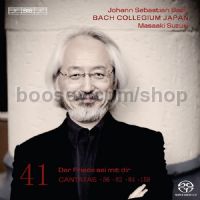J.S Bach: Cantatas vol.41 (BIS SACD Super Audio CD)
J.S Bach: Cantatas vol.41 (BIS SACD Super Audio CD)
* Estimated price converted from UK retail price
Bach Collegium Japan
Masaaki Suzuki, harpsichord
Carolyn Sampson, soprano
Peter Kooij, bass
• As on two other recent instalments (Vols 37 & 38) in his Cantata cycle, Masaaki Suzuki here concentrates on the so-called solo cantatas, providing an opportunity for two of the highly acclaimed soloists of this series, Carolyn Sampson and Peter Kooij, to shine even more brightly.
• Of the two cantatas for soprano, Ich habe genung (BWV82) is among the best-known of all of Bach’s cantatas, and was evidently held in high regard from an early stage. It was originally set for bass (and appears as such on Volume 38), and source materials show that Bach performed it at least four times. Bach’s wife Anna Magdalena must also have been especially fond of it: a partial arrangement for soprano and harpsichord was included in her second Klavierbüchlein. Ich bin vergnügt (BWV84) is a slighter work in which the oboe plays an important soloistic part. Ich will den Kreuzstab gerne tragen, the weightier of the bass cantatas, is a meditation on the cross of Jesus, but also on the suffering and need that mankind must bear. The texts, by an unknown librettist, inspired Bach to produce music of sublime earnestness, great expressive depth and full of rich, immediate imagery.
• Whereas these three cantatas were all composed during the winter of 1726-27, Der Friede sei mit dir has a less certain place in the chronology. It is in fact probable that it was assembled from movements from various sources, perhaps by an arranger rather than by Bach himself.




